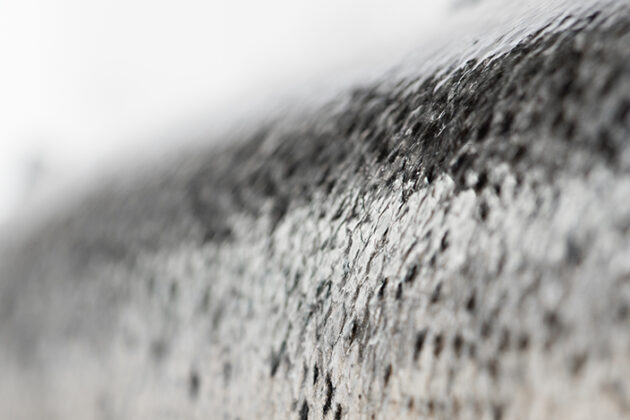Fish skin and its protective properties

Fish skin is a living organ that protects the fish against mechanical trauma as well as infections in a constantly changing and challenging environment. Although a lot is known about the biology of fish skin, there is still a lot to be discovered and understood. One thing we can say for certain, is that intact skin is important for the health and welfare of the fish.
Skin structure
Fish skin is structured into different layers, and each layer vary slightly between the different areas of the fish. Regions such as the abdomen, back, head and tail region differ when it comes to thickness, number of scales and mucus amount. However, all regions have in common three specific layers, the mucus (slime), with underneath epidermis and the dermis:
- The outer layer is a mucous layer of glycoproteins called mucins, which is why this layer is called “mucus”. This mucous layer protects the skin against mechanical wear and contains a number of antimicrobial components.
- The epidermis consists of mucosal cells (that produce the mucus) and cells called keratocytes, that form the outermost cell layer of the fish skin.
- Underneath the epidermis is the dermis, which gives the skin strength and elasticity. This layer of the skin has more blood vessels, strengthening fibres as well as pigmented cells in the deeper part of the dermis.
Each of these skin layer consists of different cell types with different functions. These structural differences mean that each layer provides important features in the protection against the surrounding environment, as components of the immune system and in the repair and regeneration of skin damage. Salmon also has scales on the main body, that are attached both to the epidermis and the dermis, and provides additional strength to the skin.
Skin and the environment
We still know very little about fish skin, like how it works and how it responds to changing environment or stressors. What we do know, is that both the thickness of the skin and the number of mucous cells are important for the fish, and that they are able to quickly react and adapt to changes in the environment.
For example, research has showed that stressed fish from flow-through systems have thinner skin, while fish from recycling facilities have a higher number of mucous cells. In other words, the fish’s skin reflects the environment where the fish live. This gives us the opportunity to sample fish skin with ‘stored’ information about the environment, and analyse them to monitor past and present fish welfare.
Fish are quite vulnerable when they are first transferred to seawater. During this period, the fish’s immune system is weaker, making it more susceptible to injuries and infectious diseases. The skin gets thinner and develops a weaker structure, while the immune system’s response is compromised. However, both will recover in time. It is still too early to conclude whether it is a single factor or a combination of biological factors, operating methods, and environmental changes that cause the weakening of salmon’s protective barriers.
Nutrition and skin health
The feed the salmon eat also has an impact on how well the skin protects the health of the fish. For example, the amount of zinc in the feed has a clear effect on the composition of phospholipids. Phospholipids are building blocks in cell membranes, and changes in composition can be of vital importance regarding the tissues’ function as, for example, a barrier against external elements.
Research has shown that the amount of omega-3 in the feed can influence how the fish utilize zinc in the feed. The different layers of the skin are strengthened by omega-3 and zinc in different ways, but in the right doses, both nutrients will help strengthen the fish’s skin and ability to heal from skin ulcers.
Further research into interaction effects and adaptation might give us better information for how we may improve the different layers of the skin, and thereby help the fish to be better prepared for different challenges in its environment.
Skin ulcer problems
Mechanical wear-and-tear damage to the skin is a widespread issue and is often linked to handling procedures. Chemical and mechanical treatment methods to combat sea lice can also have an impact, as well as crowding and pumping salmon into processing plants. The fish’s nutrition levels and immune status plays an important role in the effectiveness of its wound healing abilities. In addition, skin ulcers heal slower at lower temperatures.
Skin ulcers can be a gateway for infections. You can vaccinate against common bacterial infections, but vaccines may not be fully effective. There are also no commercial vaccines on the market that include wound-related bacteria such as Tenacibaculum ssp or Aliivibrio wodanis. To prevent wounds and skin ulcers, fish farmers try to create production processes which involve less handling of the fish – especially during cold periods. They can also use feed designed to strengthen the skin’s barrier and wound healing capabilities.
Nofima has studied what stress does to the fish’s ability to heal wounds and to produce mucus. These studies showed that immune genes are affected by stress. Immune responses are important in the protection against diseases, but may also have implications for wound healing and the normal function of the skin barrier tissue. Many of the genes that are involved in wound healing processes also work slower under stress, meaning that wounds heal slower in stressed fish. If a fish becomes acutely stressed, it loses its mucus, and it can take more than 24 hours for the mucous layer to be back to normal. This is a particularly vulnerable phase for the fish, as the mucous protects against disease.
How we measure skin health
There are a number of methods for measuring skin health and understand the relationship between the structure and function of the barrier tissue. Examination of the tissue will reveal if there are structural changes or signs of unwanted damage. We can measure the thickness of the tissue or the proportion of mucosal cells. Other more sensitive methods enable us to analyse the composition of and any signs of disease in the tissue. The detection of specific proteins in the tissue, may indicate which processes are currently underway in the tissue
Another important aspect of skin health research involves creating gene expression profiles that allow us to measure the activity of several thousand genes at once. This provides a sort of “signature”, information which makes it possible to understand what is happening in the tissue and the condition of the tissue. Depending on the research question at hand, several different methods can give us further answers – for example identifying the composition or levels of different components in the skins from fish that have received different diets, or assessing the presence of scale loss or skin ulcers.
It remains uncertain how best to measure the health of the fish and how the different measurement methods directly affect the barrier tissues. Good fish welfare is achieved not only through the absence of injuries or disease, which are the most commonly measured parameters, but also includes the fish’s ability to withstand various challenges such as changes in their immediate environment or outbreaks of new diseases.
Status of current challenges
It is especially important to know what farmed salmon can tolerate when repeated handling is required. We currently have insufficient information about which markers can be combined to be good indicators of the fish’s overall health, and which are more suitable for describing the general condition of various organs. Some methods, criteria and guidelines for assessment exist, but we still have limited knowledge about what the various measurements actually tell us about the salmon’s health and well-being, and how we could use this information to develop treatments or other interventions.
The skin consists of several different tissue types that together perform a number of important functions. The epidermis, the outermost layer of skin, is the fish’s first line of defence. When the fish is handled, for example when being treated for sea lice, there is a risk of inflicting damage or wounds that can also damage the underlying muscle. If the epidermis is weakened or disappears, some of the first-line defence mechanisms will also be impaired, and the fish’s health is at risk.
Using procedures and technology which facilitate gentle handling in combination with other preventive measures prior to handling will help strengthen the barrier tissues. An intact skin barrier will increase the fish’s ability to withstand skin ulcers and secondary infections, which in turn improves the fish’s ability to cope with future health challenges. To get to that point we need to increase our awareness, develop further knowledge and combine existing facts about the vital role the skin plays in ensuring the well-being of fish, and the understanding of how minor injuries can lead to greater health problems.
Watch film
Contact persons
Research areas


